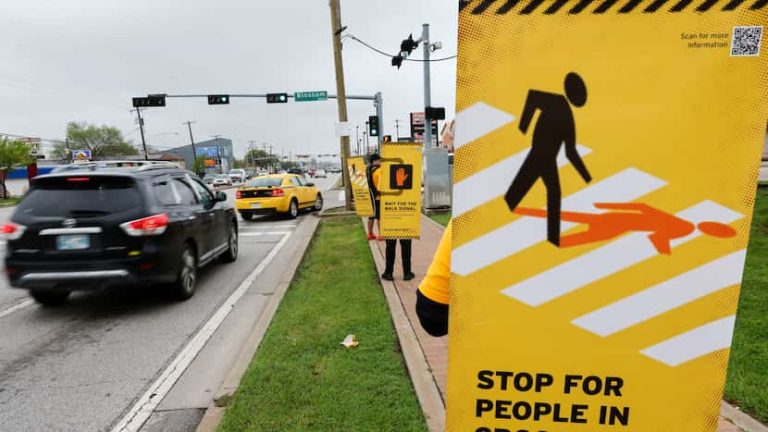Dallas faces a “huge challenge” to improve road safety as it aims to eliminate crash fatalities and cut serious injuries in half by 2030, the city’s transportation director told the Dallas City Council on Wednesday.
Dallas is moving forward with its Vision Zero plan to address traffic deaths, according to Dallas Transportation Commissioner Gus Kankari, but meeting the 2030 deadline could be tough, and city council members have expressed frustration with the pace.
During a City Council briefing on Wednesday, Dallas Police Chief Eddie Garcia said the lack of speed enforcement ultimately comes down to a lack of manpower. He said the department has 29 traffic enforcement officers who oversee a wide range of traffic issues in Dallas.
Garcia said installing speed radar cameras at red lights could help make up for staffing shortages.
“We’re certainly not going to be in a position anytime soon where we have personnel at every intersection in the city,” Garcia said, adding that police departments need a “legislative push” to implement technology that can address driving behavior.
Vision Zero Initiative
Dallas is one of more than 45 cities, including Austin, Houston and San Antonio, that have joined the Vision Zero Pledge initiative. But despite investing years in the program, these cities have made little progress toward eliminating fatal road accidents.
“Other cities are struggling with this,” Cancarli said, “and it’s a big challenge for cities as they try to implement Vision Zero concepts.”
Council members have previously expressed frustration with what they say is a slow rollout of a plan that officials first promised in 2019.
On Wednesday, city council members considered what the city can do to combat reckless driving. Should the city run campaigns? Should it do more to educate people about traffic fatality statistics? How hard should the message be?
“It’s not going to resonate with people unless it evokes some emotion, usually pain rather than happiness,” City Councilwoman Gay Donnell Willis said.
City Councilman Chad West praised the data team for analyzing where the city’s worst accidents occur, “but I’m still frustrated that we can’t do more as a city,” he said.
Kancarli told the council that the implementation process has been slowed by the COVID-19 pandemic, engineer recruitment issues, extreme weather and supply chain issues. The Department of Transportation is operating at 65% to 70% of its engineering capacity.
The city’s traffic staff also said they were facing “serious challenges” including a lack of consultant capacity, a lack of bids from contractors to build traffic lights, rising costs for work and a backlog of previously contracted work.
“It’s not that we’re not doing anything or that things aren’t moving forward,” Cancarli said, “it’s just that the nature of the market is creating significant challenges and strains on resources on the contractor side as we move forward.”
Dallas roads are among the most dangerous
According to the National Highway Traffic Safety Administration, Dallas roads are among the most dangerous in the country for pedestrians, leading some residents to advocate for pedestrian-only zones downtown.
More than half of all accidents in Dallas last year occurred on city roads. While motorists were the most common fatality group between 2019 and 2023, pedestrians also accounted for 35% of fatalities.
Approximately 7% of Dallas roads account for 57% of serious crashes and are part of the “high injury road network.” Road segments that are part of this network are prioritized for roadway investigations, with the goal of evaluating an average of five high injury roads per year. Each investigation takes 10-14 months and has an average cost of $200,000 each.
Six corridor studies, including Ferguson Road, Gaston Avenue, Lake June Road, Mountain Creek and West Clarendon Drive, are in the consultant draft report stage and 14 are in the project initiation stage. These studies allow transportation staff to identify challenges and develop plans for each road segment.
Bond funds
The Vision Zero strategy encourages designs that make streets more navigable for all users. The strategy aligns with other city efforts, such as Complete Streets, which aims to design streets that accommodate multiple transportation modes.
The 2024 bond fund allocation includes $53 million for the Department of Transportation, with $8 million allocated to Vision Zero and an additional $4.4 million to the effort through district-specific projects.
The bond also includes more than $143 million for Complete Streets and Partnership projects, including Martin Luther King Jr. Boulevard, Harry Hines to Downtown and the Frankford Road/Dallas North Tollway.
According to data from the Texas Department of Transportation, accidents often have multiple causes, but most are speed-related: Residents of Ferguson Road in East Dallas have noted speeding, running red lights, and a lack of pedestrian safety, while residents of Mockingbird Lane are calling for the installation of traffic lights after a fatal accident at a nearby intersection.
Not wearing a seat belt is also known to lead to more serious crashes, and people of color are disproportionately affected by deaths when not wearing a seat belt.
Dallas’ Vision Zero plan aligns with the Texas Department of Transportation’s Highway Safety Improvement Program, which also aims to reduce deaths and serious injuries.
The statewide program includes installing, rebuilding or replacing traffic lights on state highways. Since the department’s red light camera program was eliminated in June 2019, there has been about an 8% increase in crashes and a 50% increase in fatalities at intersections where red light cameras were once in operation, Cancarli said.
Of these, the intersection of Frankford Road and the Dallas North Toll Road in North Dallas recorded the “largest increase” of all intersections in the city, with the number of accidents increasing from 95 to 171, for a net increase of 76.
Other improvements completed or underway include new crosswalks, speed cushions and flashing signals at Adamson High School, and two new school zones each at Parish Episcopal School and Geneva Heights Elementary School.

